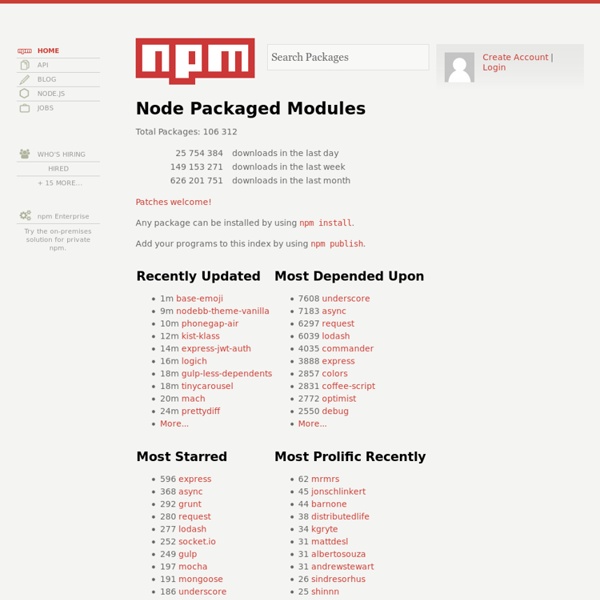Zoom
Trash
Related:



nodeschool.io nulltask/node-processing HTTP Node.js v0.10.33 Manual Stability: 3 - Stable To use the HTTP server and client one must require('http'). The HTTP interfaces in Node are designed to support many features of the protocol which have been traditionally difficult to use. In particular, large, possibly chunk-encoded, messages. HTTP message headers are represented by an object like this: Keys are lowercased. In order to support the full spectrum of possible HTTP applications, Node's HTTP API is very low-level. http.STATUS_CODES# A collection of all the standard HTTP response status codes, and the short description of each. http.createServer([requestListener])# Returns a new web server object. The requestListener is a function which is automatically added to the 'request' event. http.createClient([port], [host])# This function is deprecated; please use http.request() instead. Class: http.Server# This is an EventEmitter with the following events: Event: 'request'# function (request, response) { } Emitted each time there is a request. Event: 'connection'# or
Getting Started with NodeJS Initialize your application $ mkdir nodejs-app $ cd nodejs-app $ npm init $ npm install express --save $ echo "node_modules" > .gitignore Write a base server file server.js The process.env.PORT will read the environment variable PORT dynamically provided by our container manager. Define how to start your application Procfile web: node server.js Commit your application $ git init $ git add . $ git commit -m "Base NodeJS application" Create your application on Appsdeck and deploy You can also use our web dashboard to achieve this operation $ appsdeck create nodejs-app Git repository detected: remote appsdeck added → 'git push appsdeck master' to deploy your app $ git push appsdeck master Access your application … Waiting for your application to boot... <-- https: Now develop your project and build something amazing!
Scalingo/appsdeck-buildpack-nodejs node-inspector Overview Node Inspector is a debugger interface for Node.js applications that uses the Blink Developer Tools (formerly WebKit Web Inspector). The project maintenance and support is sponsored by StrongLoop. Table of Content Quick Start Install $ npm install -g node-inspector Start $ node-debug app.js where app.js is the name of your main Node application JavaScript file. Debug The node-debug command will load Node Inspector in your default browser. NOTE: Node Inspector works in Chrome and Opera only. Node Inspector works almost exactly as the Chrome Developer Tools. Other useful resources: Documentation specific to Node Inspector provided by StrongLoop: Running Node InspectorMiroslav's talk How to Debug Node Apps with Node InspectorDanny's screencasts (most likely outdated by now)Getting Started from scratch on wiki (most likely outdated by now) Features The Blink DevTools debugger is a powerful JavaScript debugger interface. Cool stuff Known Issues Troubleshooting I got the UI in a weird state. Yes. 1.
Debugging with node-inspector This was the fourth in a series of posts leading up to Node.js Knockout on how to use node.js. This post was recorded by node-inspector author and Node.js Knockout judge Danny Coates. Video Check out this sweet screencast where Danny explains how to use node-inspector: Transcription Hi this is Danny Coates. It's hosted on GitHub, you can go check it out there. $ node .. When I pass it the --start-brk parameter we're going to end up with two processes; the one we're debugging will be a child process of the inspector process. Let's pull up the debugger. Let me walk you through the interface. There's also a pull down menu of your JavaScript files, and some controls to step over, step in, step out and pause the script. If you click on a breakpoint it'll jump to the relevant line in your code. Let's step through the node-chat app, to see what's going on. It looks like we're setting some intervals, hooking up some routes... Let's go ahead an open a couple of node-chat windows. Thanks for watching.